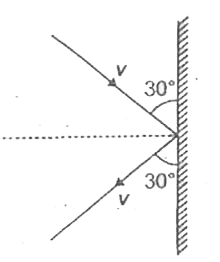Compare the impulses exerted on a wall by the two objects, a golf ball and a lump of mud both having the same mass and the veloctiy .
the golfball imparts greater impulse
the lump of mud imparts the greater impulse
both impart equal impulse
nothing can be said
The correct Answer is:A
Step by step video, text & image solution for Compare the impulses exerted on a wall by the two objects, a golf ball and a lump of mud both having the same mass and the veloctiy . by Physics experts to help you in doubts & scoring excellent marks in Class 11 exams.
Updated on:21/07/2023Topper's Solved these Questions
- NEWTONS LAWS OF MOTIONBook:NARAYNAChapter:NEWTONS LAWS OF MOTIONExercise:LEVEL -I (C.W)
Explore 47 Videos
- NEWTONS LAWS OF MOTIONBook:NARAYNAChapter:NEWTONS LAWS OF MOTIONExercise:LEVEL -II (C.W)
Explore 71 Videos
- NEWTONS LAWS OF MOTIONBook:NARAYNAChapter:NEWTONS LAWS OF MOTIONExercise:PASSAGE TYPE QUESTION
Explore 6 Videos
- MOTION IN A STRAIGHT LINEBook:NARAYNAChapter:MOTION IN A STRAIGHT LINEExercise:Level 2 H.W
Explore 29 Videos
- OSCILLATIONSBook:NARAYNAChapter:OSCILLATIONSExercise:EXERCISE - IV
Explore 41 Videos
Similar Questions
A woman throws an object of mass 500 g with a speed of 25ms−1 .
(a) What is the impulse imparted to the object ?
(b) If the object hitts a wall and rebounds with the half the original speed , what is the change in momentum of the object ?
View SolutionA woman throws an object of mass 500 g with a speed of 25ms−1 .
(a) What is the impulse imparted to the object ?
(b) If the object hitts a wall and rebounds with the half the original speed , what is the change in momentum of the object ?
View Solution
Knowledge Check
Compare the impulses exerted on a wall by the two objects, a golf ball and a lump of mud, both having the same mass and the velocity.
Athe golfball imparts greater impulseBthe lump of mud imparts the greater impulseCboth impart equal impulseDnothing can be saidThe following problems illustrate the effect of a time-dependent force of a large average magnitude which acts on a moving object only for a short duration. Such forces are called 'impulsive' forces. According to the impulse-momentum theorem, impulse delivered to a body is equal to the change of linear momentum of the body.
A ball of mass 250g is thrown with a speed of 30m/s. The ball strikes a bat and it is hit straight back along the same line at a speed of 50m/s. Variation of the interaction force, as long as the ball remains in contact with the bat, is as shown in Fig.

Average force exerted by the bat on the ball is
Let us consider another example. The given ball of mass 250g is dropped from a height 5m on a hard floor. Force exerted by the floor on the ball, as long as these are in contact, varies with time as shown in Fig.
 A5000NB1250NC2500ND7500N
A5000NB1250NC2500ND7500NThe following problems illustrate the effect of a time-dependent force of a large average magnitude which acts on a moving object only for a short duration. Such forces are called 'impulsive' forces. According to the impulse-momentum theorem, impulse delivered to a body is equal to the change of linear momentum of the body.
A ball of mass 250g is thrown with a speed of 30m/s. The ball strikes a bat and it is hit straight back along the same line at a speed of 50m/s. Variation of the interaction force, as long as the ball remains in contact with the bat, is as shown in Fig.

Maximum force exerted by the bat on the ball isA2500NB5000NC7500ND1250N
A ball of mass m strikes a rigid wall with speed v and gets reflected without any loss of speed, as shown in the figure.

(a) What is the magnitude of the impulse imparted to the ball by the wall?
(b) What is the direction of the force on the wall due to the ball?
View SolutionWhat happens to the gravitational force between two objects, if the mass of both objects are doubled and the distance between the objects is quadrupled
View SolutionA lead ball strikes a wall and falls down, a tennis ball having the same mass and velocity strikes the wall and bounces back. Check the correct statement
View SolutionTwo balls of different masses have the same kinetic energy. Then the
View SolutionA metalic ball strikes a wall and drops dead whereas rubber ball having the same mass and velocity bounces back. Which of the following is correct ?
View Solution

